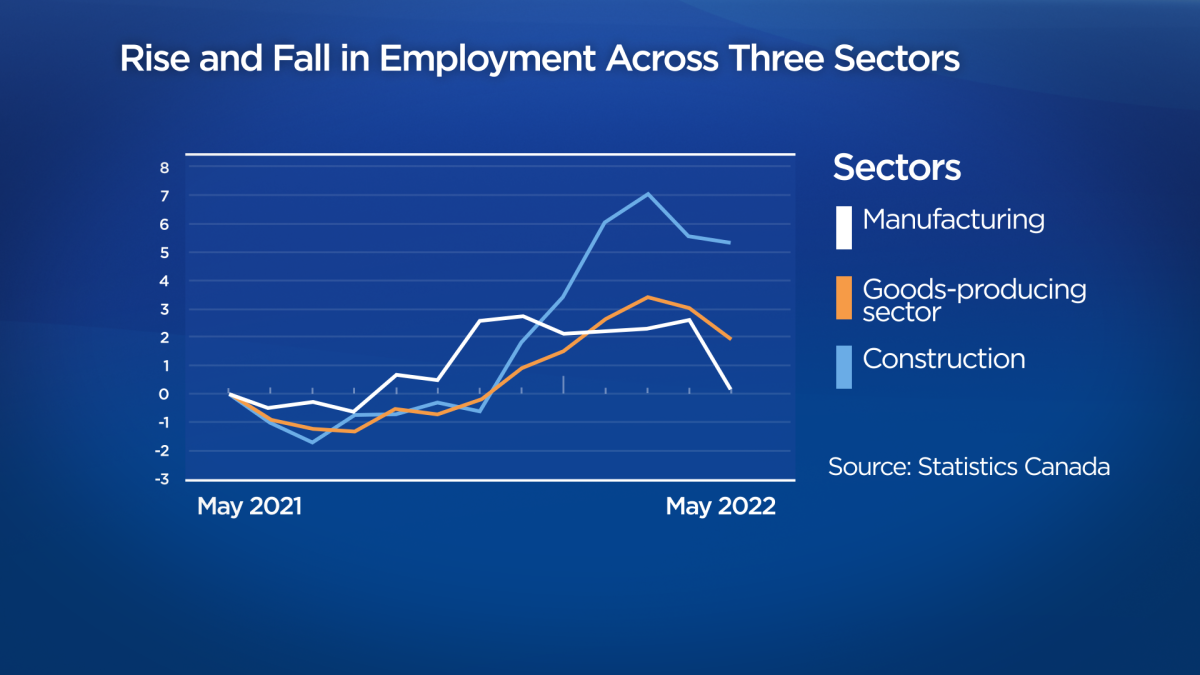The unemployment rate across Canada dropped to a new low of 5.1 per cent in May — the lowest since at least 1976 — yet some businesses are struggling to fill job vacancies. One of the main reasons for that, according to one expert, is that people are more “picky” when it comes to applying for jobs because of the impact the COVID-19 pandemic has had on the work environment.

“It’s very hard to make the argument that you need to physically come to work five days a week,” said Sarah McVanel, chief recognition officer and founder of Greatness Magnified, a company that helps organizations retain top talent and combat burnout.
McVanel says that COVID-19 presented Canadians with a different reality that changed the way people think about work.

READ MORE: Grocery store, alcohol sales down in April as prices rose: Statistics Canada
According to a report released by Statistics Canada on May 24, the number of job vacancies at the beginning of April hit just over one million, up more than 40 per cent compared to last year amid a tight labour market pushing up wages and fuelling inflation concerns.
The agency said on its website that employers in Canada were actively seeking to fill 1,001,100 vacant positions, up 23,300 from March of this year and a gain of 308,000 compared to April 2021.
Vacancies in the health care and social assistance sectors reached a record high of 136,800, up five per cent from the peak of three months earlier and up 90.9 per cent compared with the first quarter of 2020, before the COVID-19 pandemic pummelled the economy, according to a report by Statistics Canada, which was released on May 21.
The report went on to state that nurse aide positions, in addition to registered nurses and licensed practical nurses, accounted for 67.7 per cent of the overall vacancies in the health sector compared to the first quarter of 2020.
Employers in the construction industry also found it challenging to fill jobs in the first quarter, as 81,500 positions were vacant, up 7.1 per cent compared to the fourth quarter of 2021, and more than double the number observed in the first quarter of 2020.

Get breaking National news
Helper and labourer job vacancies soared 97 per cent and vacant carpenter positions were up 149.1 per cent compared to the first quarter of 2020.
Job vacancies continued to reach record highs in the manufacturing and retail trade sectors as well, up 5.3 per cent and 12.8 per cent, respectively, compared with the fourth quarter of 2021.
McVanel said people are making huge career choices right now. Many are switching industries, not just employers.
“As people are looking out there in other industries, they’re seeing how there is an ability to have a different lifestyle, so they find that they can make the same amount of money, perhaps without needing to work in an environment that’s physically uncomfortable,” she said.
According to McVanel, statistical data does not always shed light light on the real problem.
“Some businesses are struggling to keep (up), let alone attract people because of their policies, because of their work culture,” McVanel said.
“People can read on Glassdoor (about companies). That means that people don’t even apply. So this well is drying up.”
She says good qualitative data is needed to assess workplaces based on the amount of respect and recognition they have for their employees.
“If you’re not treating employees like human beings, not just as a number, and investing in their careers, then you are more than likely — no matter what sector you are in — you are less likely to be able to fill your position and attract people,” McVanel said.
An economics professor at the University of Ottawa, David Gray, says there are several obstacles coming between Canadians searching for jobs and employers looking to fill vacancies at the moment and the unwillingness to provide proper training to employees is one such.
“There are a lot of jobs begging…but there are frictions or obstacles when it comes to hiring and training employees,” said Gray.
Gray says there are jobs that “typically want their workers to be fully trained and ready to go.” But, are “often reluctant to invest in their training for fear of having their employees poached by some competing firm.”

Gray explains that there are some jobs, which require seven years or more experience, but not all companies offer the necessary training for that and are often looking for workers who already have it.
“There are jobs that you can do practically right away, but most jobs require at least some training,” he said. “You have to invest (in employees) to reduce the turnover of workers.”
The issue of filling roles “can also be alleviated by offering higher wages,” said Gray.
Another obstacle that Gray points out is commuting.
READ MORE: Pricey cottage rentals stretching vacation budget for some Canadians
“The jobs that are available, they aren’t necessarily geographically close to the location of the job searchers among the unemployed workers,” he said.
For some businesses, hiring is also an obstacle due to a shortage of affordable places for workers to rent. One such business that’s struggling is Fish & Sips in Collingwood, Ontario.
The owner Paul Heather said in an interview with The Canadian Press on Saturday that “it’s the affordability, but also the availability” that’s causing the issue.
“There isn’t enough rental stock for people to choose from,” said Heather.
He also said that his latest kitchen hire couldn’t find a place in town and commutes by car — another hurdle when gas prices are soaring and regional public transit lags.
Rentals.ca, a Canadian website for apartment rental searches, said the average rent for all Canadian properties listed on its site rose 10.5 per cent year over year to $1,888 per month in May. The average national home price topped $700,000 last month, up 41 per cent from two years earlier as mortgages ballooned from Vancouver Island to Atlantic Canada, according to the Canadian Real Estate Association.

— With files from The Canadian Press










Comments